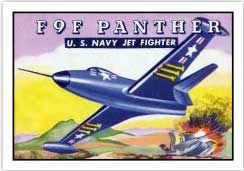
1952 Topps Wings: A Theory on 3rd and 4th Series Printing
I bought my first Topps Wings cards from Terry Duvall in March of 2003. I bid on two of Terry's cards (#119 and #123) on eBay, just for the heck of it. I had some of them as a kid and thought it would be fun to get a couple to see if they were as cool as I remembered them to be - they were! I bought a few more cards over the next couple of months. The colors and artwork on some of the cards was fantastic. Number 100, to the left, is a good example. In June of 2003, I won card #152 that happened to be graded and slabbed by Sportscard Guarantee, LLC. The card looked awesome in the SGC holder. I knew at that point I wanted to finish the set, and have them all graded by SGC. I next bought a bunch of SGC-graded cards from the legendary Bill Bengen, and have been working on the set ever since.
Topps Wings cards consist of 200 aircraft subjects: color paintings of planes of late 1940s and early 1950s vintage. The paintings were produced from photographs supplied by the New York Herald Tribune. The set was assigned American Card Catalog number R707-4. A silhouette-based "NAME THIS PLANE: FRIEND or FOE" quiz appears on the card backs. The cards were sold in both 1¢ and 5¢ wax packs, as well as 5¢ cello packs. The cards measure 2 5/8" x 3 3/4". The complete set of 200 Wings cards were reissued with larger side borders by Doeskin Tissues in the fall of 1955. They have "Doeskin" printed on the back in the copyright area. The Doeskin Wings set was assigned the ACC number F381. The Doeskin Wings cards measure 2 5/8" x 4 3/8". Complete packages of these tissues, including the card, are sometimes offered on eBay.
As with most Topps products of the early 1950s, the cards were probably printed on sheets of 100 subjects. Since the set has a total of 200 cards, it was most likely printed and sold in four series, 50 cards at a time. The cards seem to be available in a fairly even distribution with no great rarities, although, as with most cards of the 1950s, the last series cards are harder to come by than the others. In order of difficulty I would rank series 3 (cards 101-152) the easiest to obtain, followed by series 2 (51-100), then 1 (1-50), and lastly series 4 (153-200). The first and last cards of the set are extremely difficult to obtain in near mint, or better condition. They are usually found off-center and pretty much looking like the cat dragged them in. The exact issue year for Topps Wings cards seems to be a mystery. Bob Nolan writes in The Wrapper, No. 97, that he remembers buying them in January of 1952. I have a vendor box that shows a 1952 copyright. Sportscard Guarantee, LLC insists they're a 1953 issue. Others claim they came out in 1954. I remember buying them as a kid, but feel certain it was later than 1952. I certainly remember not buying them and 1952 Topps baseball cards at the same time. Probably they came out in varying forms in all three, or even more years. For another interesting look at the set, check out Kurt Kuersteiner's article in issue No. 207 of The Wrapper.
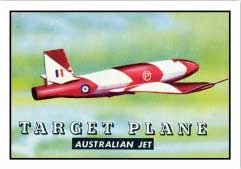 |
As my collection grew, I got a feel for the cards in the set, which numbers were more difficult to obtain than others, and how the cards were printed and distributed. Here’s what I’ve learned. For some reason, there were a few cards that you just couldn’t find in decent shape. Included in this list are cards numbers 1, 118, 149, 156, 174, 193, 197, and 200. The high numbers I could understand. Card #153, the Bristol 171 Mk-3, is one of the worst-looking planes I’ve ever seen. Beginning with card #154, Topps ran off eleven straight helicopters. I’m sure these were thrown out by the scores in 1952. But, if the 3rd series was so plentiful in the marketplace, why were cards #118 and #149 so hard to find? The answer came to me in the form of one of my best eBay purchases, ever. In July of 2006, my friend, Alex Abela, and I won a fantastic lot of cards on eBay. The lot was described as: |
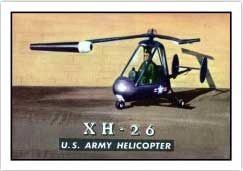 |
|---|---|---|
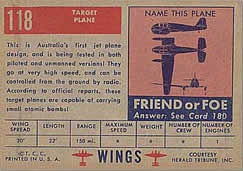 |
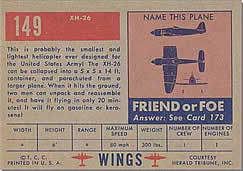 |
|
4th Series - #118 Front & Back |
4th Series - #149 Front & Back |
| "Wings Topps Spotter Cards & Box 110 Total Excellent - Cards are in excellent condition, clean sharp corners, 110 total with original box. This may be a complete box of wax packs, opened and put back in the original box". |
|---|
That's exactly what we got. I've never seen such nice cards before, or since. They did appear to have been opened, put back in the box, and forgotten for 54 years. On the box, aside from the 1952 copyright notice, it stated that the box contained 24 5¢ packs. 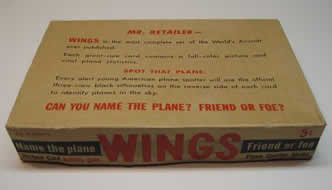 If the packs contained five cards each (like the 1952 Topps baseball card 5¢ packs), that would mean that the box originally contained 120 cards. Another thing caught my eye. On the back of several cards was what looked to be a gum stain. Not a wax stain that's usually confined to the two vertical edges of the card backs, but a rectangular stain the size of a piece of bubble gum. Knowing that the gum was usually found on the top of the first card in each wax pack, I surmised that the box contained cello packs, where the gum was found behind the bottom card of the pack. There were 21 cards in the box that showed evidence of gum on the back. If two packs were removed from the box originally, that would account for there being 110 cards left. It would have been better if I had found 22 cards with gum stains, for the math to come out just right - maybe I missed one.
For the record, all copies of the following cards had gum stains on the back: 101(2), 106(2), 109(2), 117(2), 133(2), 134(3), 140(2), 142(2), 143(2), and 146(2).
If the packs contained five cards each (like the 1952 Topps baseball card 5¢ packs), that would mean that the box originally contained 120 cards. Another thing caught my eye. On the back of several cards was what looked to be a gum stain. Not a wax stain that's usually confined to the two vertical edges of the card backs, but a rectangular stain the size of a piece of bubble gum. Knowing that the gum was usually found on the top of the first card in each wax pack, I surmised that the box contained cello packs, where the gum was found behind the bottom card of the pack. There were 21 cards in the box that showed evidence of gum on the back. If two packs were removed from the box originally, that would account for there being 110 cards left. It would have been better if I had found 22 cards with gum stains, for the math to come out just right - maybe I missed one.
For the record, all copies of the following cards had gum stains on the back: 101(2), 106(2), 109(2), 117(2), 133(2), 134(3), 140(2), 142(2), 143(2), and 146(2).
As nice as the cards were, it was the distribution of cards that interested me the most. Of the 110 cards in the box; there were ten cards from the 1st series and 100 from what I now believe to be the 3rd series. If you were paying attention to the first part of this article, you would remember that I defined the 3rd series as cards #101-152, not #101-150. In the box there were at least one of all cards from 101 to 152, with the exception of 2 cards #118 and #149. The following table lists the complete box breakdown.
# of Cards Found |
Card Numbers Included |
Total 110 |
|---|---|---|
0 |
4, 118, 149 |
0 |
1-each |
1, 2, 3, 5, 6, 7, 9, 10, 116, 121, 136, 138 |
12 |
2-each |
8, 101-110, 113-114, 117, 119-120, 122-133, 135, 137, 139-148, 150-152 |
86 |
3-each |
111, 112, 115, 134 |
12 |
Maybe those two cards were not part of the 3rd series, but held out by Topps and printed with cards #153 to 200 to make up the 4th series. As you may recall, Topps did the same thing with its 1953 baseball card set - holding cards out of one series and printing them with the next series[1] . This action supposedly increased sales by having kids chase cards that weren't out yet.
There's another piece of evidence that makes me think that this theory is true. On the card backs is the "FRIEND or FOE" quiz. The first two series of cards dealt with this in a logical fashion by having the answer to the quiz appear on the next card in sequence. For example the answer to the "FRIEND or FOE" quiz on card #9 (shows silhouette of a Cutlass) was found on card #10. 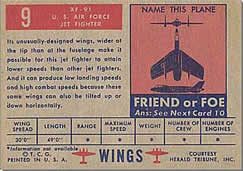
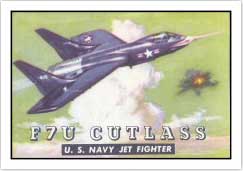 The answer to the quiz on card #100, can be found on card #1. Each card stated "Ans: See Next Card XX". The 3rd and 4th series go about the quiz in an entirely different way. On the back of these two series' cards, it states: "Answer: See Card XXX". The answers to the quiz were scattered all over the place. Lots of planes are not shown in silhouette on any cards at all. Many cards have the same silhouette on their backs. However, all 3rd series cards had the answers contained within the series. The quiz answers to cards #151 and #152 were found on cards #110 and #125 respectively. The fact that they were in the box, and the fact that their quiz answers were contained on other 3rd series cards convinced me that cards #151 and #152 belong in the 3rd series. But what about cards #118 and #149? Eureka! The answers to their quizzes appear on 4th series cards #180 and #173. That makes them a part of the last series, and explains why they weren't in the box and are harder to find than other 3rd series cards.
The answer to the quiz on card #100, can be found on card #1. Each card stated "Ans: See Next Card XX". The 3rd and 4th series go about the quiz in an entirely different way. On the back of these two series' cards, it states: "Answer: See Card XXX". The answers to the quiz were scattered all over the place. Lots of planes are not shown in silhouette on any cards at all. Many cards have the same silhouette on their backs. However, all 3rd series cards had the answers contained within the series. The quiz answers to cards #151 and #152 were found on cards #110 and #125 respectively. The fact that they were in the box, and the fact that their quiz answers were contained on other 3rd series cards convinced me that cards #151 and #152 belong in the 3rd series. But what about cards #118 and #149? Eureka! The answers to their quizzes appear on 4th series cards #180 and #173. That makes them a part of the last series, and explains why they weren't in the box and are harder to find than other 3rd series cards.
Well, that's my theory. The 1952-3-4 Topps Wings cards 3rd series contains the 50 cards numbered 101-152, without cards #118 and #149. The 4th series contains cards numbered 153-200, including cards #118 and #200. Does the same kind of thing hold true for the first two series? I think probably not. In fact maybe cards 1-100 were all released at the same time. Maybe Topps used the hold-out method with the last two series to increase sales. Is this kind of analysis going to win me a Pulitzer? Probably not, but to me it was a lot of fun.
All Topps Wings cards can be seen in living color on the Skytamer Web site.
I would be extremely interested in corresponding with any readers who share my fascination with the Topps Wings set. If any reader can verify or poke holes in this theory, please send an e-mail to the Webmaster, below.
UPDATE: in February of 2008, I bought a partial sheet of Wings high numbers that contains card no. 149.
[1]Anyone wishing to read more about the printing of Topps 1952 and 1953 baseball cards should read George Vrechek's in-depth analysis posted to "The Library" on the Old Baseball Card Web site.
| [Return to Top] |